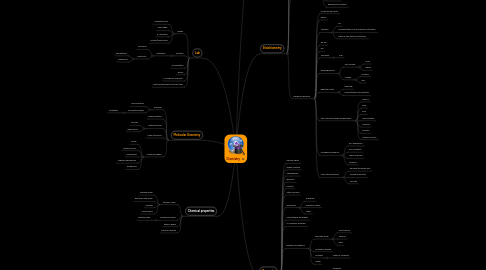
1. Lab
1.1. Redox
1.1.1. Cathod/Anode
1.1.2. Salt bridge
1.1.3. e- direction
1.1.4. Voltaic/electrolysis
1.2. Titration
1.2.1. Indicators
1.2.1.1. pH paper
1.2.1.2. Solutioins
1.2.1.2.1. Phlaphtalein
1.2.1.2.2. Methylred
1.3. Precipitation
1.4. Buffer
1.5. Le Chatelier Principle
1.6. Factors that affect reaction rates
2. Molecular Geometry
2.1. Bonding
2.1.1. Ionic bonding
2.1.2. Covalent bonding
2.1.2.1. Strengths
2.2. Hybrid orbitals
2.3. Multiple bonds
2.3.1. pi bond
2.3.2. sigma bond
2.4. Lewis Structure
2.5. Molecular shape
2.5.1. Linear
2.5.2. Trigonal planar
2.5.3. Tetrahedral
2.5.4. Trigonal Bipyramidal
2.5.5. Octahedral
3. Chemical properties
3.1. Periodic Table
3.1.1. Alkaline metal
3.1.2. Alkaline earth metal
3.1.3. Halogen
3.1.4. Noble gases
3.2. Ionization Energy
3.2.1. Identification
3.3. Atomic Raddi
3.4. Electron Affinity
4. Nomenclature
4.1. Potassium
4.2. Potassium Chloride
4.3. Net-ionic
4.3.1. Molecules
4.3.2. Acids
4.4. Organic
4.5. Name of reaction
4.6. Change in state
5. Stoichiometry
5.1. Measurement
5.1.1. Significant zeros
5.1.2. Accuracy
5.1.3. Precision
5.1.4. Data analysis
5.2. Balancing equations
5.2.1. Direct
5.2.2. Half reaction (redox) involve ions
5.3. Nuclear chemistry
5.4. Electrochemistry
5.4.1. Voltaic cell
5.4.2. Cell emf under nonstandard
5.4.3. Electrolysis cell
5.4.4. Free E & redox
5.5. Chemical thermodynamics
5.5.1. Calculation of S
5.5.1.1. Sign
5.5.1.2. Delta S
5.5.2. Gibbs free E
5.5.3. Equilibrium constant
5.6. Aqueous equilibria
5.6.1. Common ion effect
5.6.2. Buffer
5.6.3. Titration
5.6.3.1. pH
5.6.3.2. Concentration in four process of titration
5.6.3.3. Ratio of one particle to another
5.6.4. Ka, Kb
5.6.5. pH
5.6.6. Solubility
5.6.6.1. Ksp
5.6.7. Heterogeneous
5.6.7.1. Not include
5.6.7.1.1. Solid
5.6.7.1.2. Liquid
5.6.7.2. Include
5.6.7.2.1. Solution
5.6.7.2.2. Gas
5.6.8. Reactioin rates
5.6.8.1. Rate law
5.6.8.2. Concentration of reactants
5.6.9. Ways of expressing concentration
5.6.9.1. Mass %
5.6.9.2. ppm
5.6.9.3. ppb
5.6.9.4. Mole fraction
5.6.9.5. Molarity
5.6.9.6. Molality
5.6.9.7. Partial pressure
5.6.10. Colligative property
5.6.10.1. b.p. depression
5.6.10.2. m.p. elevation
5.6.10.3. Vapor pressure
5.6.10.4. Osmosis
5.6.11. Ideal gas calculation
5.6.11.1. Effusion/Diffusion rate
5.6.11.2. Molecular kinetics
5.6.11.3. Velocity
6. Concepts
6.1. Nuclear chem
6.2. Redox reaction
6.3. Spontaneous
6.4. Ideal gas
6.5. Entropy
6.6. State function
6.7. Acid/Base
6.7.1. Arrhenius
6.7.2. Bronsted-Lowry
6.7.3. Lewis
6.8. Strong/weak Acid/Base
6.9. Le Chatelier principle
6.10. Reaction mechanics
6.10.1. Reaction order
6.10.1.1. First-half life
6.10.1.2. Second
6.10.1.3. Zero
6.10.2. Activation energy
6.10.3. Catalyst
6.10.3.1. Types of catalysts
6.10.4. Media
6.11. IMF
6.11.1. 5 types of solid structure
6.11.1.1. Hardness
6.11.1.2. Boiling point
6.11.1.3. Melting point
6.11.2. 4 types of IMF
6.11.2.1. ion-dipole
6.11.2.2. dipole-dipole
6.11.2.3. London dispersion
6.11.2.4. Hydrogen bonding
6.11.3. Lattice energy
6.12. Colloids
6.12.1. Hydrophilic
6.12.2. Phobic
6.13. Liquids
6.13.1. Factors that affect solubility
6.13.2. Saturated/ Unsaturated
6.13.3. Solution formation and energy change
6.13.4. Property
6.13.4.1. Viscosity
6.13.4.2. Surface tension
6.13.5. Vapor pressure
6.13.6. bp/mp
